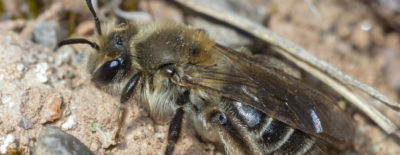The dazzling wildflower show of rich northern hardwood forests in early May is accompanied by an equally fascinating, but much less appreciated flush of bee activity. The mining bee species below are all tied to particular spring ephemerals, and possible to ID from clear photos in association with their host plant.
Genus level ID: See the Mining Bee page for tips on separating other genera.
Click each box for more details on a given species.

Trout-lily Mining Bee (Andrena erythronii)
This large, brown mining bee is moderately distinctive and widespread in the state. Its abundance and level of dependence on Trout Lily are both uncertain at the moment. Image Courtesy Denis Doucet

Spring Beauty Mining Bee (Andrena erigeniae)
This is one of the most abundant bees in hardwood forests in the spring. Image Courtesy Michael Veit

Mustard Miner Bee (Andrena arabis)
The specific plant requirements of this species are a bit murky, though most records are from members of the Brassicaceae family. Try looking for it on Toothwort. One historical VT record.

Andrena uvulariae
A tiny mining bee associated with Bellworts (Genus Uvularia), within which they can very hard to notice. Males have a yellow clypeus. Not yet recorded in Vermont. Photo Courtesy Michael Veit

Andrena ziziaeformis
No photos could be found for this small bee that specialize in Cinquefoils and Appalachian Barren-Strawberry (this photo).

Andrena violae
This violet specialist is far less common than its host plant in Vermont. So far only known from a few records in Windsor County.

Cranesbill Miner (Andrena distans)
First confirmed in Vermont in 2020, this species is likely dependent on Wild Geranium which is most common in southwestern VT.

Waterleaf Mining Bee (Andrena geranii)
Virginia Waterleaf blooms a bit later than other spring ephemeral, usually after leaf out is complete. This associated bee is only known from a few records in Vermont, but might have been overlooked in the past.
Specialization data primarily from Jarrod Fowler.






